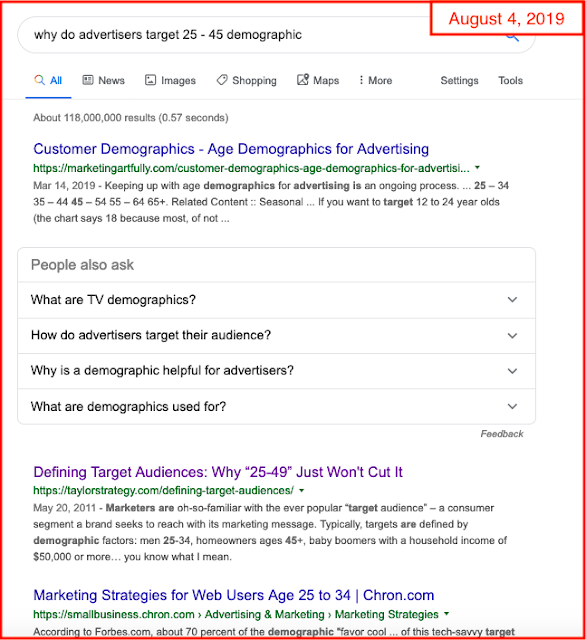This was taken from the article at this link.
***********************************
Back to Idle Rambling
The Bakken seems to be slow right now (in terms of news). If one needs any proof of that, look at the top stories post for the last week; and, look at the number of wells coming off the confidential list this next week.
Pitiful.
So, I have time for a lot of reading. Which is wonderful.
But before I do that, I just had an epiphany, thanks to a reader.
A reader happened to mention "buying habits."
Our back-and-forth discussion led me to google: why do advertisers target 25 - 45 demographic --
The second hit: Taylor Strategy.
The reader ...
[...by the way, the reader was raised in rural North Dakota; has been quite successful in life; has much more common sense than I do; and, is much more articulate than I am, so this is someone I take seriously ... okay, I take all my readers seriously ... ]
The reader wrote:
Years ago, I espoused the notion that one's life spending patterns were set at around age 45. If, at that age one was driving a Geo, it would be just plain wasteful to drive a Mercedes. However, were one to drive a Mercedes at age 45, driving a KIA would be just plain shameful. Surprisingly, my notion has held true and I've tested it against a number of people's behaviors. Of course, there are the exceptions to the "rule"....I replied, less articulate but hopefully you get the point:
Your theory about spending habits is quite correct, I'm sure -- that's why advertisers focus so much on the 25 - 45 age demographic. That demographic doesn't have the most money; they certainly don't have the most disposable income (though many may spend like they do) but marketers want to establish buying habits by 45 when these folks will have more money.Back to Taylor's strategy linked above. The writer is absolutely correct. However, that writer was answering a slightly different question. That writer was asking, "If, as an advertiser, you target the 25 - 45 age group, how should you target them?"
That is an entirely different question than what age group should advertisers target (yes, it certainly depends on the item being advertised...but in general ...let's talk big ticket items and/or items used through all stages of life: houses, cars, food, soft drinks, lifestyle, entertainment, insurance, computers, smart phones, clothes, etc. -- we're not talking children's toys or Depends, here)...
I think that's why successful companies market to the 25 - 45 age demographic. I do believe US seniors are the wealthiest demographic with the most time on their hands, but their lifestyle and buying habits -- as suggested by the reader -- are established by age 45.
Maybe everyone knew that except me.
Okay, back to reading:
- Claremont Review of Books, spring issue
- The Annotated Wuthering Heights, edited by Janet Gezari, c. 2014
Red Meat Republic: A Hoof-to-Table History of How Beef Changed America, Joshua Specht, c. , 2019.It seems I've seen this book before; perhaps someone --even this reader -- recommended this book and I have completely forgotten.
************************************
Three Books I'll Want To Peruse At Barnes and Noble
Peruse: to examine carefully at length [before buying].
- Darwin's Doubt: The Explosive Origin of Animal Life and the Case for Intelligent Design, Stephen C. Meyer; 512 pages, $29
- The Deniable Darwin and Other Essays, David Berlinski, 558 pages, $40
- Debating Darwin's Doubt: A Scientific Controversy That Can No Longer Be Denied, edited by David Klinghoffer, 350 pages, $25


No comments:
Post a Comment